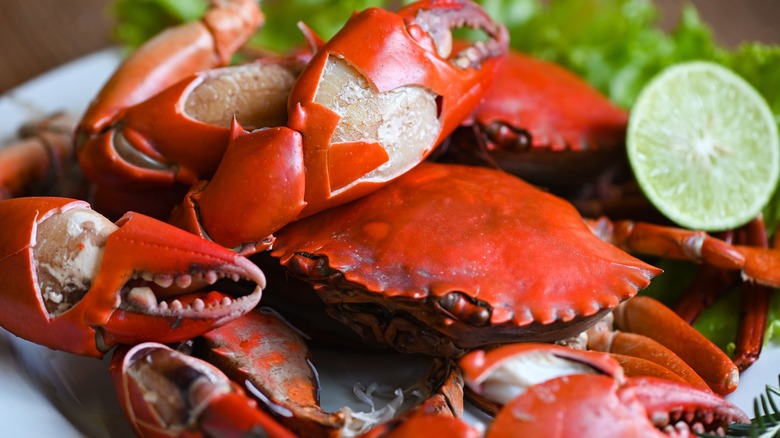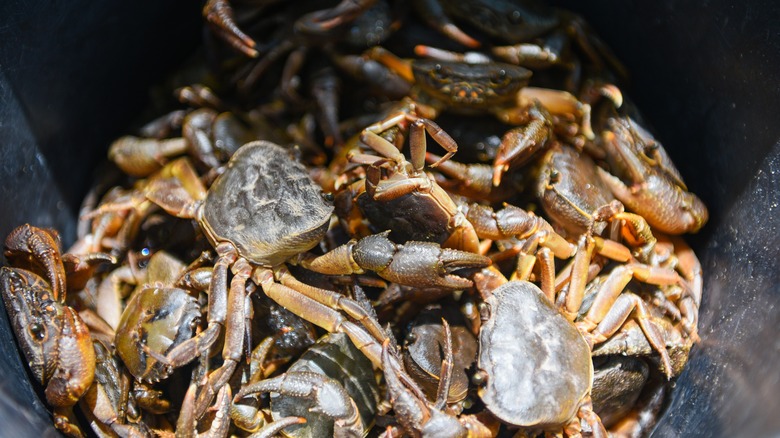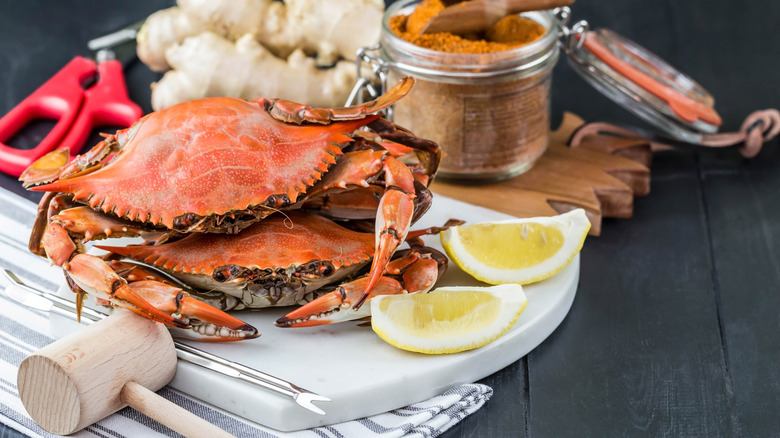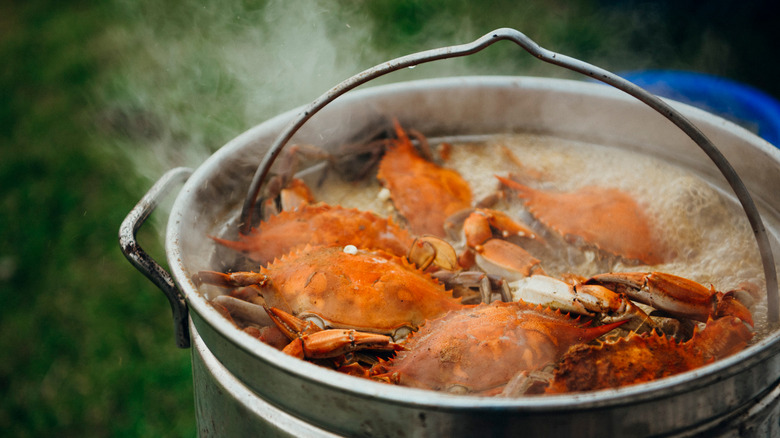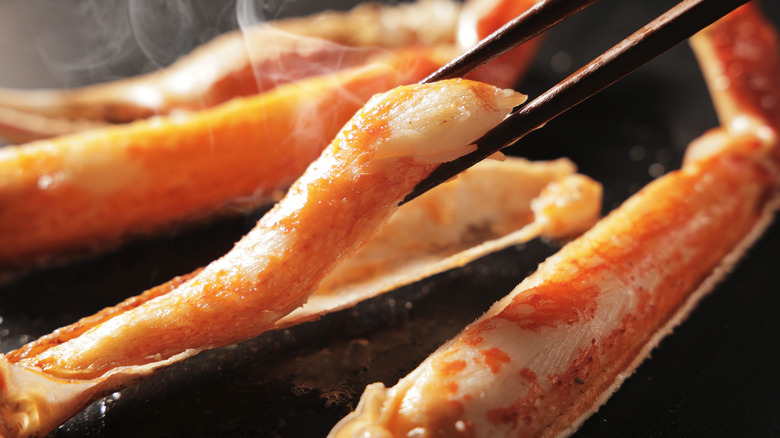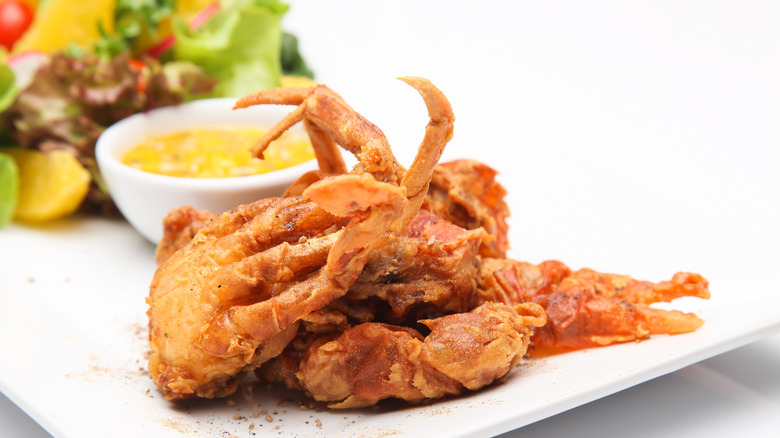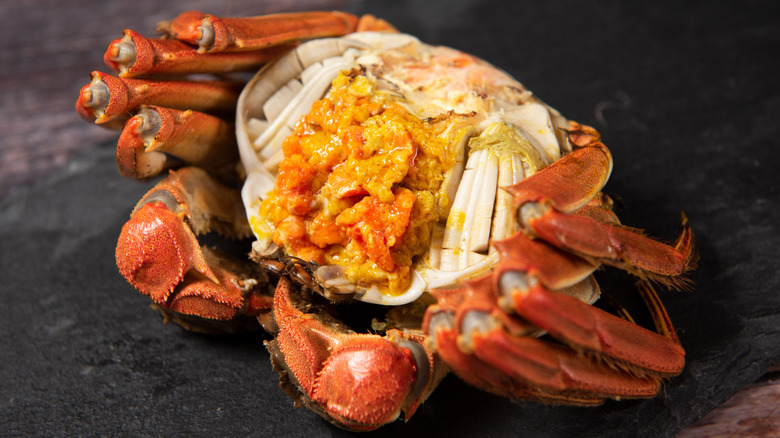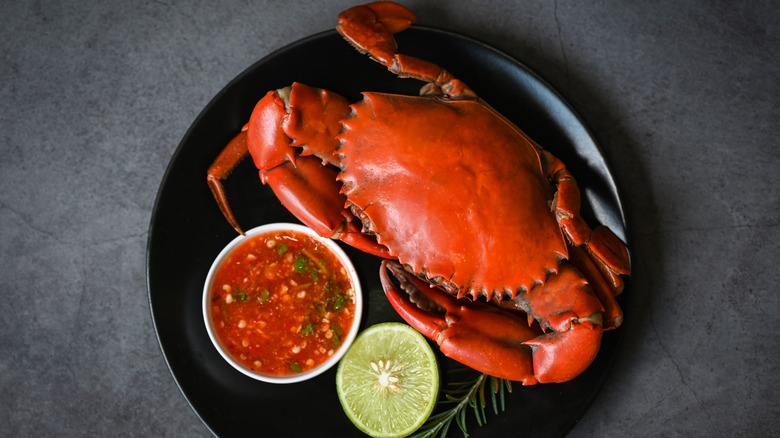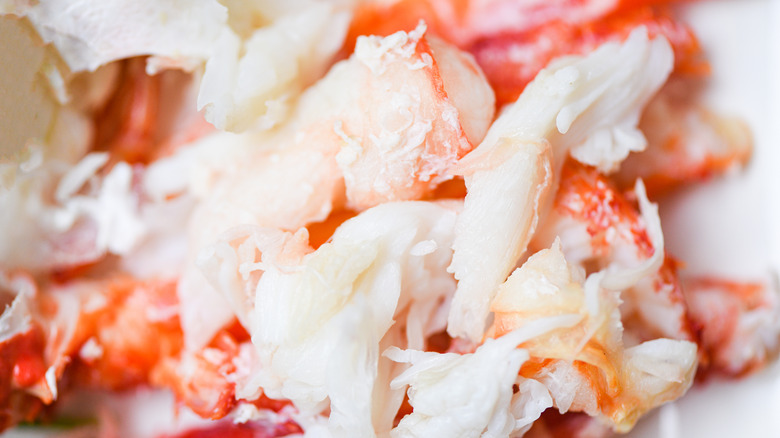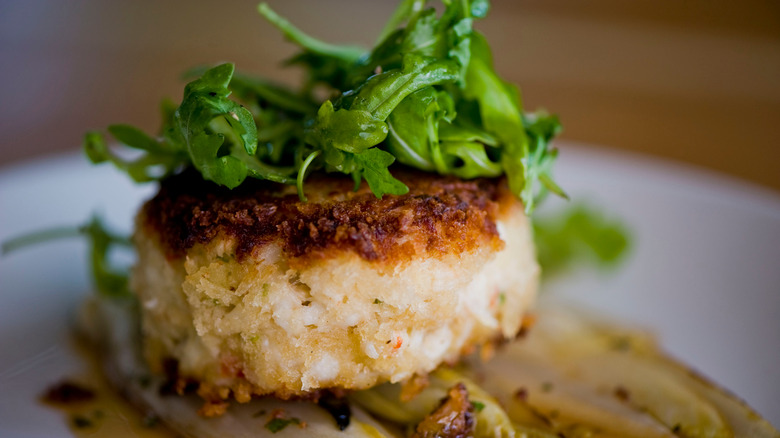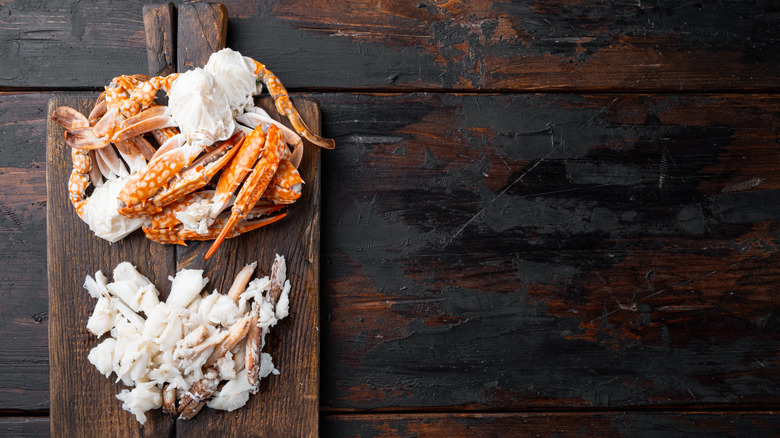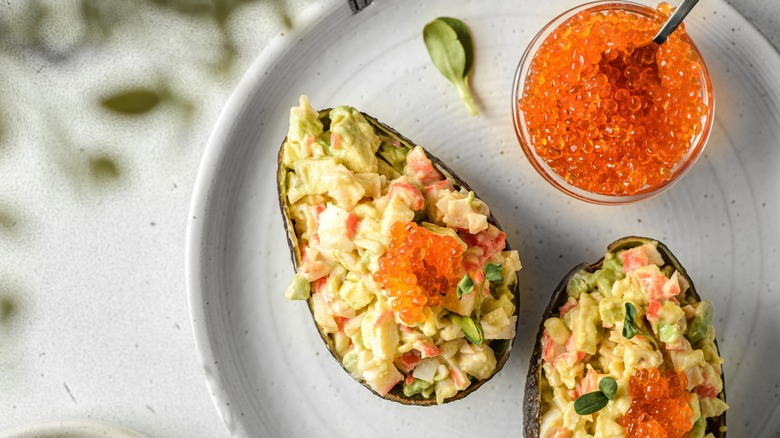12 Tips You Need When Cooking With Crab
A versatile and fun treat, crab is a favorite seafood item for many. Its relatively mild flavor gives something for everyone to like, whether that is cooked whole in a seafood boil or using the picked meat in a crab cake. This crustacean has a luxury feel while not being quite as expensive as lobster.
While crab may be a popular shellfish option, not everyone knows how to cook with it. If this ingredient feels foreign to you, you are not alone. With so many different species, it can be hard to know how best to prepare this delicious animal.
To get some advice on cooking with crab, we spoke with Jeremy Sewall, chef/owner of Row 34 in Boston, Burlington, and Portsmouth. Coming from a strong line of fishermen in his family, Sewall is notorious in New England for his seafood dishes. He is here to help you cook the best crab possible.
Tips for buying crab
Making the most of cooking crab starts with sourcing. Chef Jeremy Sewall advises buying live crabs that are in good shape. "Make sure the crabs are very lively," he says. The freshest crabs will still have spunk. There's plenty to know when buying crab, but one key rule is if they are barely moving, pass on them, and never buy dead raw crabs.
When it comes to fresh crab, buying local is best. Crustaceans, like other sea creatures, have various species that live in different regions of the ocean. Sewall said he is "a big fan of sticking with local crab." Based in Boston, he loves to cook with fresh Jonah crab, which are from New England. Other regional specialties include Dungeness crab in California, king crab in Alaska, and blue crab in the Mid-Atlantic.
If you don't live in a coastal area or want to try a species from a different region, there are plenty of online vendors that will ship you live crabs. Look for companies with quick product turnover and pay attention to when the crabs are in season. If you don't want to mess with live crabs, frozen pre-cooked crab products, from legs to claws, can be great options. Since the amount of meat differs greatly by species, you will need to know the average weight of meat per crab for the variety you are cooking. As a general rule, make sure you will have about ⅔ to ¾ pound of meat per person.
When to steam crabs
If you ask a Marylander how to cook crabs, they will tell you steaming is best. In the traditional Chesapeake Bay-style crab feast, blue crabs are steamed over a flavorful liquid of water, beer, and apple cider or malt vinegar. After steaming, the crustaceans are tossed onto paper-lined tables and doused with Old Bay seasoning.
Maryland chefs believe steaming is the best method for blue crabs. They find boiling leaves them waterlogged and mushy. Steaming results in succulent crabs that have their briny and sweet flavor left intact. Sewall isn't a Maryland chef, though, and is not married to steaming. He expresses admiration for the Mid-Atlantic method of preparing crabs, but he adds that unless you have a huge steamer like restaurants in the area will have, it can be very inconvenient to steam crabs at home. "Steaming takes longer and is great for a small number of crabs," Sewall says. "However, it is easier to boil in a large batch. The crabs will cook more evenly." So if you're cooking for a crowd, boiling might be the way to go.
When to boil crabs
Sewall is a fan of boiling whole crabs, in particular blue crabs from Maryland and meaty Dungeness crabs from the West Coast. For best results, he instructs to add aromatics (such as onion, garlic, and herbs like parsley) along with salt to a pot of water and brings it to a boil before adding the crabs. For extra flavor, throw some Old Bay seasoning into the water. This is not the traditional way of cooking crabs in the Mid-Atlantic, but Sewall insists this will give you results that are just as good, and possibly even better when cooking a larger volume.
Some crab species, like stone crab, are also best when boiled. With big meaty claws, stone crabs are typically boiled to preserve texture and flavor. The claws are then most often served chilled, similar to a shrimp cocktail. The same can be said for Jonah crab. Sewall loves Jonah crab claws for an appetizer at holiday dinners. You will often see frozen crab "cocktail" claws that were boiled before freezing. These claws are already cracked open to expose the meat for an easy dining experience.
When to bake crabs
You will not see a lot of recipes that call for baking whole crabs, but there are situations where baking is an excellent cooking method. Crab legs benefit from some oven time. In this recipe for the easiest oven baked crab legs, pre-cooked crab legs are heated to perfection in about 15 minutes at 400 degrees Fahrenheit. This technique is not meant to cook the crab but simply reheat them. You will have flaky, tender crab legs ready to be devoured.
Baking crabs is also a common technique in Chinese cooking (via Rasa Malaysia). Whole crabs can be "baked" in a hot wok covered with a lid for about 8 minutes or on a tray in the oven for 15 to 20 minutes at 400 degrees F. In either case, the crabs will turn bright orange when cooked. Blue crab, Dungeness crab, snow crab, and king crab all work for this method, and the cooked meat makes a good topping for fried rice and Chinese noodle dishes.
When to fry crabs
Crabs have a hard, inedible exoskeleton. Since you don't eat crab shells, there is no sense in frying whole crabs. However, there is one exception. When crabs molt, there is a brief period where their shells are thin and tender enough to eat.
These soft-shell crabs are a Mid-Atlantic specialty (all soft-shell crabs on the market are blue crabs, although all crab species molt). The most common way to eat soft-shell crabs is to deep fry or pan fry them whole and eat the entire animal. Although some people are freaked out by the sight of the whole crabs on the plate, many people love them because it is the only time you can eat whole crabs without having to crack open the shell and dig out the meat.
The best way to cook soft-shell crabs is to dredge them in seasoned flour and fry them. Simple preparations like this help give these crabs their signature crunch and preserve their flavor. You can accompany the crabs with bright flavors through a dipping sauce, slaw, or other side dishes, but you don't want to mess too much with the blue crab flavor.
To clean or not to clean crabs
A common confusion with crabs is when and how to clean them. Cleaning refers to the process of removing the inedible parts of the crab, such as the lungs, called gills. This process may also be called dressing.
When you cook whole crabs, there is no need to clean them before they are cooked. However, they do need to be cleaned to eat them. When ordering crabs at a restaurant, such as in the traditional Maryland-stye steamed blue crabs, they most likely will serve the crabs whole, leaving the job of cleaning to the diner. At home, you may decide to clean the crabs for your dinner guests for an easier eating experience.
To clean cooked crabs, pull off the abdominal covering, called the apron, and remove the back shell. You also want to discard the gills, internal organs, and mandibles. Some crabs, like Dungeness, will have this yellow fatty substance, called "mustard." Saving any liquid from the shell and the mustard will give you a more flavorful bite. With soft-shell crabs, you will always want to clean them before cooking. To clean soft-shell crabs, you will remove the apron, gills, and tail. Plus, you will cut off the face to kill them. Cleaning soft-shell crabs before you cook them will ensure you don't eat any of the unpleasant parts of the animal when you eat them whole.
How to know when crab is cooked
When you first start cooking crabs, you may struggle with knowing when they are done. The good news is the crabs will signal when they are ready. Crabs turn bright red when they are cooked. This change in color occurs through a chemical reaction.
Different species of crabs will range in color from brown to blue to grey, but they all have a pigment in their shell called astaxanthin, which is stored in a membrane called crustacyanin. This pigment absorbs blue light, but when exposed to heat, it is released from the crustacyanin and the pigment is activated, revealing the red color.
When the shells turn red, that is your sign that the crab is just about done cooking and should be removed from the heat momentarily. If you are still not confident in your ability to determine when your crabs are done, you can relax. According to Sewall, crabs can be forgiving, and he adds that it is better to slightly overcook crab than to undercook it.
Don't ignore picked crab meat
Eating whole crabs can be fun, but it can also be a tiring process. You have to put in a lot of work to get to the meat. It's one of the few instances you might actually burn more calories during the meal than you consume. As Sewall puts it, "eating crab requires persistence." You may decide the labor is not worth the results. If this describes you, you don't have to miss out on eating crab.
Don't sleep on picked crab meat. Sold both raw and cooked, shelled crab meat is a convenient way to eat these popular crustaceans. Crab meat is designated into four grades: jumbo lump, lump, backfin, and claw. The meat ranges in price from $25 to $50 per pound depending upon grade, with jumbo lump being the most expensive and most prized with its big chunks of meat.
Sewall's favorite ways to put crab meat to use include crab cakes, a chilled crab salad, or simply adding it to a pasta dish. "Crab has a richness so acid is a great pairing. It's a pretty forgiving ingredient and loves to be paired with a variety of ingredients," he says.
Recipes using crab
The versatility of crab provides almost endless culinary opportunities. You may choose to eat the crabs whole, making them the centerpiece of your meal. For certain species with substantial meat in the legs, such as king crab, you might buy just the legs to serve with melted butter.
The most common way to utilize crab is by featuring the meat as a component in a recipe, whether you pick the meat yourself or buy it pre-shelled. You can never go wrong with classic Maryland crab cakes, which are broiled to perfection in just 7 to 8 minutes. Another popular use for crab meat is in crab and corn chowder. Like other chowders, this recipe uses potatoes and is thickened with a little bit of flour.
With native species all around the world, crab can be found in cuisines from Chinese to Italian. Crab meat makes for a great ravioli filling and as a topping to an Asian-style noodle dish. Plus, the shells can be simmered with aromatics to make a flavorful stock, which can be used in dishes from bisque to risotto.
How to store cooked crab
To prevent foodborne illness, it is crucial to store crabs properly. Crabs can live for a couple of days outside of the ocean. Store live crabs in a cooler of ice or in the refrigerator, but make sure they are not in standing water or directly on ice (via Crabbing Hub). Cook crabs within one to two days and do not cook any crabs that died while in refrigeration.
Fresh crab meat should be consumed within three to five days of cooking. Some crab meat may be pasteurized, however, as a food safety measure. In this case, the crab meat is heated in a tin or plastic container for about two hours and then cooled for two hours in an ice bath (via Crustacea Corp). Similar to milk, the pasteurization process helps eliminate bacteria that result from the picking process.
Pasteurized crab meat can last up to 18 months unopened, but unlike canned tuna, it does need to be stored in the refrigerator. Once opened, pasteurized crab meat has the same shelf life as unpasteurized cooked meat. The same time frame applies to cooked meat still in the shell. Crab meat gives some strong indicators when it has gone bad. The meat will smell rancid and taste sour or bitter. If you notice these signs, toss the remaining meat.
How to reheat cooked crab
When properly stored, cooked crab meat can last up to five days in the fridge. Leftover crab meat can still be enjoyable if you follow these tricks. You can reheat crab legs by boiling or steaming them for no more than five minutes. You can also bake them in the oven or throw them on the grill. If you are going to use the microwave, make sure to do it correctly. Wrap the crab legs in wet paper towels and a layer of plastic wrap and microwave for just two minutes.
For crab meat, you can gently reheat it on the stove or throw it into a dish as part of the cooking process. Just remember that cooked crab meat only needs to be warmed. It won't take nearly as long as it would if you were cooking raw meat.
While crab meat can be a little forgiving and won't completely dry out if cooked a couple of minutes too long, you can also avoid overcooking it by not reheating leftovers. If you take Chef Sewall's recommendation of a chilled crab salad, you can repurpose leftovers without cooking it again.
